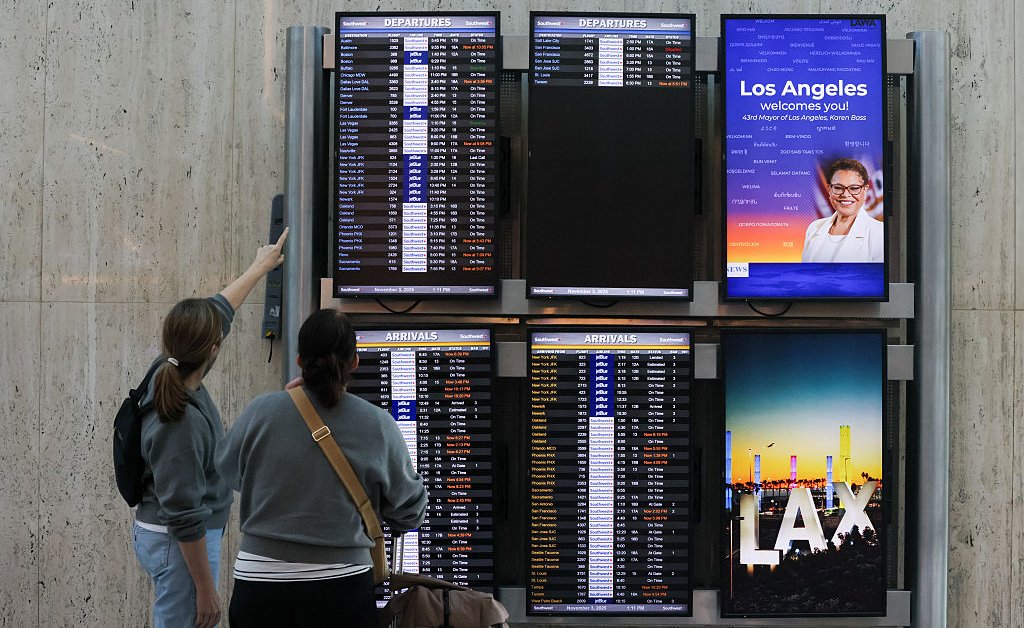Air travelers are feeling the impact of the longest government shutdown in U.S. history as they’re forced to deal with flight cancellations and delays due to a shortage of on-duty air traffic controllers.
And flight travel is set to get a whole lot more inconvenient as Transportation Secretary Sean Duffy announced on Wednesday that he is ordering a 10% cut in flights at 40 major U.S. airports, citing air traffic control safety concerns.
The Federal Aviation Administration (FAA) is set to publish an order, finalizing the move, on Thursday, with the cuts expected to come into effect on Friday. The FAA has also warned that it could enforce additional flight restrictions moving forward, if further air traffic issues come to light.
“I’m not aware in my 35-year history in the aviation market where we’ve had a situation where we’re taking these kinds of measures. We’re in new territory in terms of government shutdowns,” said FAA Administrator Bryan Bedford at a press conference on Wednesday.
The FAA is around 3,500 air traffic controllers short of its typical staffing levels and many have been working grueling schedules filled with overtime shifts and six-day weeks.
Duffy had previously raised air travel safety concerns in early October.
“I want them [air traffic controllers] to think about the departures and arrivals of airplanes. I want to make sure they keep Americans, and airplanes, safe,” said Duffy during a press conference at Newark Liberty International airport in New Jersey. “But they’re not just thinking about the airspace, they’re thinking about: ‘Am I going to get a paycheck?’ ‘How am I going to pay my mortgage?’ ‘How do I make my car payment?’ ‘Do I have to take a second job and drive Uber?’”
On Oct. 30, the Association of Flight Attendants-CWA issued an urgent plea for the government shutdown to end, referring to it as an “unsustainable crisis.”
“Air traffic controllers, TSA officers, and other workers required to work without pay missed their first full paycheck this week,” they said, highlighting additional concerns that “more than 40 million people, including flight attendants, will [soon] lose SNAP food assistance.”
Airlines are now gearing up for the flight cuts and making plans for how to support their customers during this time.
“Any customer traveling during this period is eligible for a refund if they do not wish to fly—even if their flight isn’t impacted. That includes non-refundable tickets and those customers with basic economy tickets,” United Airlines CEO Scott Kirby told TIME in an emailed statement on Thursday morning.
Per Kerby, United will provide “rolling updates” regarding the upcoming changes, in an effort to give “customers several days’ advance notice and to minimize disruption for them.”
The airline’s international long-haul flights and “hub-to-hub flying” are not set to be impacted by the FAA directive. United says its hub airports are Chicago O’Hare, Denver International, Guam’s Antonio B. Won Pat, Houston George Bush, Los Angeles International, Newark Liberty, San Francisco International, and Washington Dulles.
Delta Airlines told TIME that it “expects to operate the vast majority of [their] flights as scheduled, including all long-haul international services.” The company emphasized that safety is the “top priority.”
As air travel safety concerns mount, and the disruption to passengers is set to increase, here’s what to know:
Why are there so many flight delays and cancellations?
There were almost 3,900 delays and over 170 cancellations at airports across the U.S. on Wednesday alone.
Due to some staff not coming into work without pay, Duffy said that those who are turning up to work face immense pressures.
“They’re working longer hours, they’re working more days, and that’s some of the pressure that we’re seeing on them, and we want to alleviate that pressure before it becomes an issue,” he said, outlining his plan for cuts.
Citing performance data, the FAA echoed Duffy’s concerns, with Bedford telling press: “We are starting to see some evidence that fatigue is building in the system… we need to work towards relieving some of that pressure.”
Which airports are set to be affected by the flight cuts?
Neither Duffy nor Bedford confirmed Wednesday which airports in particular would see a reduction in their traffic, but said that it would not be based on specific airlines. That news is set to come shortly.
“We’ve identified 40 high-traffic environment markets. We’ll be happy to share that later,” said Bedford.
According to the FAA, the 40 busiest airports in the U.S. in 2024 all saw over 5 million passengers passing through.
Those airports included Hartsfield-Jackson International in Atlanta with 52.5 million passengers, Dallas-Fort Worth International with 42.3 million, and Denver International with 40 million. Chicago O’Hare, Los Angeles International, and JFK International in New York all served over 25 million passengers in 2024.
So far this week, Hartsfield-Jackson International has seen 762 delays and 20 cancellations, with Dallas-Fort Worth experiencing 825 delays and six cancellations, plus Denver International has dealt with 594 delays and 12 cancellations, according to Flight Aware.
“We have decided that a 10% reduction in scheduled capacity would be appropriate to again, continue to take the pressure off of our controllers, and as we continue to see staffing triggers, there will be additional measures that will be taken in those specific markets,” said Bedford. “We’re going to look for a radical reduction across these 40 markets over the next 48 hours.”
When asked how long these reductions will last, Duffy said that it would depend on the data that the FAA and Department for Transport are actively examining.
The post Flight Cuts to Hit 40 Busiest U.S. Airports Due to Government Shutdown. Here’s What to Know appeared first on TIME.



